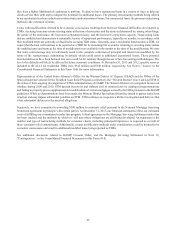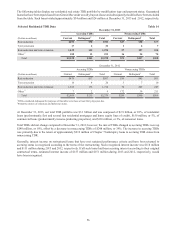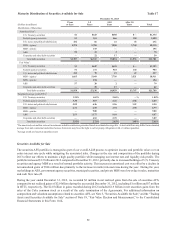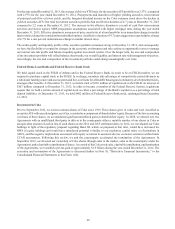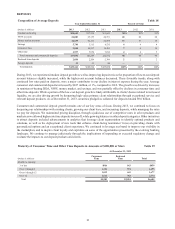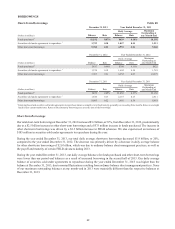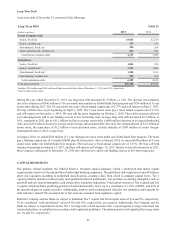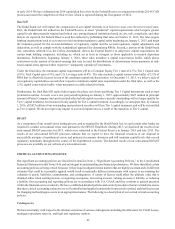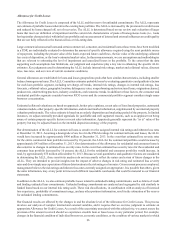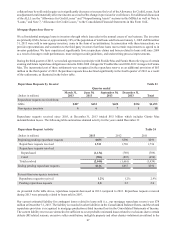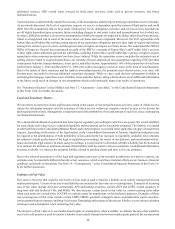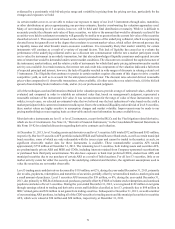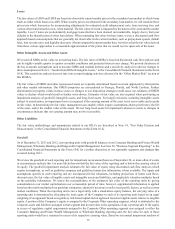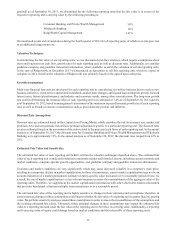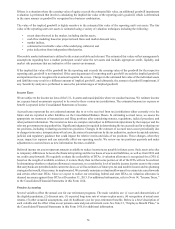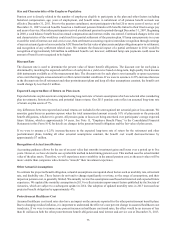SunTrust 2013 Annual Report Download - page 81
Download and view the complete annual report
Please find page 81 of the 2013 SunTrust annual report below. You can navigate through the pages in the report by either clicking on the pages listed below, or by using the keyword search tool below to find specific information within the annual report.65
in early 2014. We have submitted our 2014 capital plan for review by the Federal Reserve in conjunction with the 2014 CCAR
process and await the completion of their review, which is expected during the first quarter of 2014.
Basel III
The Dodd-Frank Act will impact the composition of our capital elements in at least two ways over the next several years.
First, the Dodd-Frank Act authorizes the Federal Reserve to enact “prudential” capital requirements which require greater
capital levels than presently required and which vary among financial institutions based on size, risk, complexity, and other
factors. As expected, the Federal Reserve used this authority by publishing final rules on October 11, 2013. The rules require
banking organizations such as us to meet revised minimum regulatory capital ratios beginning on January 1, 2015, and begin
the transition period for the revised definitions of regulatory capital and the revised regulatory capital adjustments and
deductions, as well as comply with the standardized approach for determining RWAs. Second, a portion of the Dodd-Frank
Act, sometimes referred to as the Collins Amendment, directs the Federal Reserve to adopt new capital requirements for
certain bank holding companies, including us, which are at least as stringent as those applicable to insured depositary
institutions. Furthermore, beginning January 1, 2016, these rules introduce a capital conservation buffer, which places
restrictions on the amount of retained earnings that may be used for distributions or discretionary bonus payments as risk-
based capital ratios approach their respective “adequately capitalized” minimums.
Under the final rules, the minimum capital requirements will be a Common Equity Tier 1 ratio of 4.5%; Tier 1 Capital ratio
of 6%; Total Capital ratio of 8%; and U.S. Leverage ratio of 4%. The rules include a capital conservation buffer of 2.5% of
RWA that is effectively layered on top of the minimum capital risk-based ratios. At December 31, 2013, we believe each of
our regulatory capital ratios exceeds their respective minimum capital ratio requirements under the final rules, as well as the
2.5% capital conservation buffer, when measured on a fully-phased-in basis.
Furthermore, the final Basel III capital rules require the phase out of non-qualifying Tier 1 Capital instruments such as trust
preferred securities. As such, over a two year period beginning on January 1, 2015, approximately $627 million in principal
amount of Parent Company trust preferred and other hybrid capital securities currently outstanding will no longer qualify for
Tier 1 capital treatment, but instead will only qualify for Tier 2 capital treatment. Accordingly, we anticipate that, by January
1, 2016, all $627 million of our outstanding trust preferred securities will lose Tier 1 capital treatment, and will be reclassified
as Tier 2 capital. We do not expect any impact to our total capital ratio as a result of the transition to Tier 2 capital.
DFAST
As a component of our overall stress testing process, and as required by the Dodd-Frank Act, we and certain other banks are
required to conduct semi-annual stress tests pursuant to the DFAST Final Rule. During 2013, we disclosed the results of our
semi-annual DFAST processes for 2013, which were submitted to the Federal Reserve in January 2013 and July 2013. The
results of our semi-annual DFAST processes indicate that we expect to have the financial resources at our disposal to
successfully navigate a hypothetical severe and protracted economic downturn and will maintain capital levels that exceed
regulatory minimums throughout the course of the hypothetical scenario. The detailed results of our semi-annual DFAST
processes are available on our website at www.suntrust.com.
CRITICAL ACCOUNTING POLICIES
Our significant accounting policies are described in detail in Note 1, “Significant Accounting Policies,” to the Consolidated
Financial Statements in this Form 10-K and are integral to understanding our financial performance. We have identified certain
accounting policies as being critical because (1) they require judgment about matters that are highly uncertain and (2) different
estimates that could be reasonably applied would result in materially different assessments with respect to ascertaining the
valuation of assets, liabilities, commitments, and contingencies. A variety of factors could affect the ultimate value that is
obtained either when earning income, recognizing an expense, recovering an asset, valuing an asset or liability, or reducing
a liability. Our accounting and reporting policies are in accordance with U.S. GAAP, and they conform to general practices
within the financial services industry. We have established detailed policies and control procedures that are intended to ensure
that these critical accounting estimates are well controlled and applied consistently from period to period, and that the process
for changing methodologies occurs in an appropriate manner. The following is a description of our current critical accounting
policies.
Contingencies
We face uncertainty with respect to the ultimate outcomes of various contingencies including the Allowance for Credit Losses,
mortgage repurchase reserves, and legal and regulatory matters.


